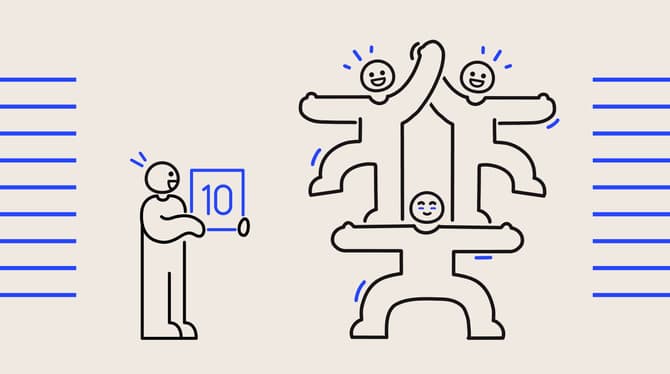The future of performance management is continuous, coaching-based and people first. It’s time to motivate, not stagnate your teams.
A sports coach is a winner when the team is victorious. A conductor puts on a great concert when the orchestra performs amazingly. And a manager’s success is measured by their employees’ performance, both as individuals and as a team.
✨Learn more about how to give employee performance feedback
Sure, taken as a whole, a great team achieves more than a sum of its parts. But teams begin with individuals, each with their own personal objectives, quirks, struggles, and unique style of fitting in with the group.
Leading a high-performing team in today’s dynamic work environment first means properly leading the team’s individual players. How? Shifting your style and your mindset from the dated conception of performance management to one that focuses on employee development. In defining this shift, you’ll see how this upgraded managerial style breeds highly-motivated employees and the ability to crush performance goals.
Exclusive online summit
·
May 23 2024
Moments that matter: how to seed great work
What's in this article
So what was (and is) performance management?
Simply put, performance management is the process of managing employees’ performance.
While the term might remain, the form of management used to help employees perform their best is under mega transformation.
The industrial mid-20th century image of factory workers in grease-stained overalls was the heyday of performance management. It regulated every aspect of how a worker should do a job, and used intimidating reviews and the infamous dangling carrot to make sure workers didn’t stray from rigid rules.
Think of them as “little production machines” that you could easily replace if they didn’t get the job done, as Josh Bersin explains. It wasn’t really about the people, it was about the labour and the output.

The majority of companies today are still stuck with an outdated performance management process. This means going through an annual performance review, preceded by a performance appraisal and some kind of self-evaluation form. Usually, these are also followed by performance planning and goal setting.
It’s not that these processes are necessarily “broken”, but the workplace has changed, and so too have its workers who now bring to the office their toolkits packed with intelligence, creativity, soft skills, and a healthy obsession with personal and professional growth.
In today’s workforce, people are at the center of things and managers now serve employees in a bottom-up relationship, unlike when workers feared their managers. The concepts of management and leadership have taken big strides, which means that performance management needs an upgrade, too. It’s time to be more agile and frequent with goal-setting, measuring progress, and feedback.
It’s time to focus on continuous employee development.
Modern workers need coaches, not bosses
Today’s individuals don’t want (and won’t stick around for) one repetitive task, even if they can manage it with hardly any effort.
The path of least resistance is no incentive to take a job. Employees want work that changes and challenges.
They want to apply their full stack of intellectual, creative and social skills, and to constantly develop new ones to meet the ever-mounting challenges you set with them.
At the base, performance stems from an employee’s feeling that they are positively contributing to something bigger than themselves, learning as they go, with a sense of purpose and meaning.
So when smart, savvy and socially-networked employees don’t feel their job is fulfilling, you bet they’ll be taking all that valuable intellectual and creative energy elsewhere.
That’s where you come in!
Holding onto staff by recognizing, developing and challenging them sets a modern thriving enterprise apart from one destined to stagnate and fold.
Swapping out the mindset of performance management for employee development means providing a work environment where modern employees don’t feel stuck in a repetitive rut, where they aren’t pushed beyond the boundaries of their greatest potential.
Let’s get to how to make this happen.
Getting serious about employee development
Research heavyweight Gallup has recently described “a cultural shift in how people work and how they work together.”
The shift goes from this ineffective form of performance management where manager is “boss”:
- Dictating unclear expectations
- Giving infrequent feedback
- Acting like a boss who doesn’t need to be fair or accountable
To this form of employee development where manager is “coach”:
- Establishing expectations together
- Communicating more frequently and openly
- Acting like a coach who is accountable and fair
Let’s dig in a little further to each of these so you can apply them in your day-to-day.
Further reading: our recent Officevibe study uncovered three major insights that prove to be great pillars in improving employee performance, backed by our own engagement survey data.
Agree on roles, goals and expectations together
The old conception of performance management meant dictating to workers what they are to do and how, without necessarily considering their input. It was a one-way street.
But without their input, can you really get their buy-in? The best way to have your employees feel accountable for their job is to ensure clarity around their role by setting expectations together. The more involved they are in the process, and the more input they have, the more loyal and performing they will become.
Each time an employee fulfills their goals and objectives, which you set together, the trust between you gets a positive-reinforcement kick.
Keep a constant dialogue going and get to know your people
A huge part of employee development is what we might call communication management: it’s the opposite of the traditional performance management mindset, which reduced interactions to mistrustful constant supervision and infrequent reviews.
It’s time to rethink your annual performance reviews (we did). They can inhibit someone’s motivation to take chances by tying performance to money (or the threat of getting fired), encouraging conformity at best, and dishonesty at worst. And with so much time in between, it’s a wonder anyone can accurately review the thing being reviewed.
Instead, frequent communication management won’t miss what is gained in the very human process of creative problem solving. It emphasizes the employee’s journey, not just their output or their worth whittled down to a yearly dollar sign. Replace performance appraisal reviews with chats, check-ups and coaching sessions. If you need to prepare for these conversations, try using one-on-one meeting templates.
The key word here is ‘continuous,’ not once a year.
And, your chats and check-ins don’t always need to be formally tied to performance. Take the time to get to know your employees as people, and let them get to know you, too. This might be your greatest tool in the box for building trust and creating a safe space for candor and vulnerability.
Be fair, consistent and offer forward thinking feedback
When offering feedback on employee performance, make sure the feedback now makes sense with the expectations set earlier. How can you be trusted as a manager if you can’t be counted on to stand by your word? Keep organized, keep track and check in often to make sure that you’re on the same page regarding the expectations you set.
As much as feedback needs to be aligned with the previous goals that were set and agreed on, it also needs to be framed in a future-pointing mindset.
All feedback—including constructive criticism—should help employees feel motivated to develop, instead of anxious about looking back. Feedback shouldn’t focus solely on catching someone falling behind on their expectations. It should focus on what’s next for the employee, whether it be working on certain skills that aren’t yet mastered, or moving beyond mastered skills to a new challenge. When you’re in it together, this is when development takes its best form.
Show employees that you have a stake in their development by not being afraid of difficult conversations and that you are accountable for their success by coaching ahead, and being part of the journey with them, instead of the puppeteer.
Managers need feedback, too
If you’re trusted as accountable for the expectations you’ve set with your employees and the feedback you’re giving, then by letting them give you feedback, they take some of that accountability back on themselves.
Not to mention that constructive feedback is infectious. And, if feedback helps you become a better manager, it’s your team that reaps those benefits. Getting honest feedback from people on your team requires tact, trust and respect.
Letting your employees know that you, too have room for improvement and are on the same journey of development will humanize you and level the playing field.
There are some great tools out there to facilitate this feedback process. Officevibe is a platform that fosters a safe feedback space between managers and the teams they lead.

What’s Next? From individuals to teams and beyond
Employee development and communication management empowers each individual, who when banded together form high-performing teams, every manager’s dream. They teach and learn from each other, and combine into fresh talent-matrixes for the co-creation of great content, products and ideas.
Every individual is unique. By upping the frequency and quality of your coaching sessions, you’ll get to know each unique personality much quicker. The time you put into learning about your individual players will not go unappreciated. You can check out our one-on-one software and start applying what you learned today!
And of course, knowing each individual better is how you help them grow and exceed their goals.
The most valuable asset you’re overseeing are the personalities and experiences of your team, all of which stem from within each individual, but bloom under accountable and motivating leadership.
You got this, coach! 🚀




